Explore Multichannel Fundraising Advice from the Experts

Have you ever heard of the “Rule of 7?” This concept asserts that to keep donors engaged and motivate them to continue supporting your work, you should contact them at least seven times in the year following their gift. One of the most effective ways to implement this concept is via multichannel fundraising.
This strategy involves connecting with donors through several distinct offline and digital marketing channels. By engaging with donors across multiple channels, you’ll foster lasting, positive relationships and keep your mission at the forefront of their minds. In this guide, we’ll explore the basics of multichannel fundraising and how to leverage each channel to achieve your goals:
- Multichannel Fundraising 101: The Basics
- 6 Channels to Leverage in Your Multichannel Campaign
Grounding your knowledge in the basics will empower you to adapt and scale multichannel fundraising strategies according to your nonprofit organization’s evolving needs and objectives. Let’s begin.
Not a marketing expert? With Allegiance Group + Pursuant, you don’t have to be.
Multichannel Fundraising 101: The Basics
What is multichannel fundraising?
A multichannel fundraising strategy involves using a variety of communication channels and methods to engage supporters. These may include both online and offline methods, such as email, direct mail, social media, SMS marketing, search ads, your website, and more. Nonprofits share communications across all these channels simultaneously to maximize visibility, enhance reach and engagement, and foster increased awareness among their target audiences.
Multichannel vs. Omni-channel
Although some may use the terms “multichannel” and “omni-channel” interchangeably, there are key differences between the two strategies. Here’s what sets them apart:
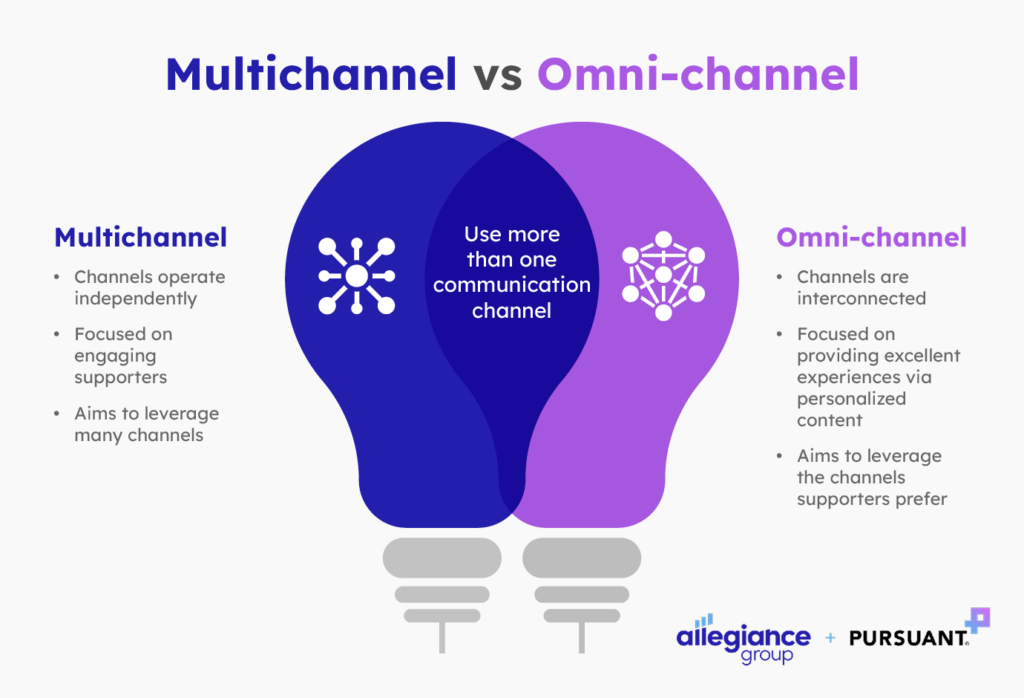
- Multichannel Fundraising
- Channels operate independently of one another
- Focused on engaging supporters
- Aims to leverage many channels
- Omni-channel Fundraising
- Channels are interconnected and seamlessly flow supporters from one to the next
- Focused on providing excellent supporter experiences via personalized content
- Aims to leverage the channels supporters prefer
Simply put, multichannel marketing or fundraising is about reaching supporters via multiple channels, while omni-channel marketing takes this a step further by cultivating a layered, integrated experience.
Because omni-channel marketing is more holistic and focused primarily on building long-standing relationships with supporters, many organizations opt for this strategy.
Ultimately, these strategies should build on one another. Start here by learning the multichannel basics and practicing the strategy, and, as you grow your program, you can shift to an omni-channel approach. Our team can assist with each step of this growth journey, so contact us today if you need help!
Discover the advantages of omni-channel marketing with this detailed resource.
Why is multichannel fundraising important?
Engaging with supporters across a variety of channels offers several benefits, including:
- More touchpoints with current and prospective donors: Using multiple communication channels means more opportunities to engage donors. This can also increase your reach, helping you spread awareness to audiences you may not have connected with using limited channels.
- More donations and engagement: You won’t get donations or additional engagement if you don’t ask for it. By making your needs known via multiple channels, you’ll receive the revenue, volunteer hours, and event attendance you’re looking for.
- Higher retention rates: As mentioned, an established online presence across several channels will boost your nonprofit’s visibility. This will keep your mission and work on donors’ minds, reminding them to continue supporting your cause.
- More opportunities to maximize involvement: Each time you connect with a donor, you can pitch upgrades, recommend new ways to engage, encourage them to join your sustainer program, etc. Deepen relationships by gathering new data about donors through their responses to your communications.
Of course, you’ll need to consider which advantages best align with your nonprofit’s goals when selecting a fundraising strategy.
A simple, multichannel approach might be the best option for small shops or newer nonprofits focused on building awareness. On the other hand, larger, more established organizations should aim for an integrated, omni-channel approach. If you’re unsure which strategies will best suit your organization’s needs, reach out to our experts at Allegiance Group + Pursuant.
What are the steps to getting started?
The steps to kicking off a multichannel fundraising campaign will vary from organization to organization, but most nonprofits follow a process similar to this one:
- Set specific, measurable goals. Outline what you want to accomplish with the campaign, ensuring you can objectively evaluate your goal (e.g., “We will raise $100,000 by the end of the fundraiser.”).
- Identify your audience and conduct audience and market research. Analyze data about your target audience, whether current or prospective supporters. Use both internal and external data sources for a well-rounded understanding of their preferences, behaviors, and motivations.
- Develop a unified central message. This overarching theme will serve as the foundation for every message you share during the campaign. For example, a conservation organization might launch an “Adopt an Endangered Animal” campaign that rallies support to protect endangered species and their native habitats.
- Select communication channels. Depending on audience preferences and usage, determine which channels you’ll use. We’ll cover the most popular communication channels next.
- Create a marketing plan. Lay out the details of how, when, and where you’ll execute your communication strategy. Explore our nonprofit marketing plan guide for more direction.
- Set up tracking mechanisms. One pain point of multichannel and omni-channel campaigns is accurate attribution (identifying which tactics lead to donations or other conversions). Ensure you have the right tools to track attribution before launching the campaign.
- Plan and create engaging content. This content must grab your audience’s attention, educate them about your cause, and inspire them to take action—all while aligning with the central message. Before you start from scratch developing new content, think about all of your organization’s existing content and whether it can be refreshed or repurposed. This will save you time.
- Launch the campaign. Deploy your messaging, and track engagement data in real time, like email clicks and unsubscribes; ad impressions and clicks; return on ad spend (ROAS); and conversions like providing an email or donating. Make small tweaks to the campaign as needed to enhance results.
- Review and report campaign outcomes. Once the campaign wraps up, analyze your key performance indicators (KPIs). Did you meet your goals? Were there any unexpected wins or weaknesses?
This process can be lengthy and complex, especially for larger organizations. Working with a specialized agency will save your staff time and equip your organization with the expertise and industry connections needed for a thriving fundraiser.
6 Channels to Leverage in Your Multichannel Campaign
Email marketing is one of the most effective ways to reach your target audience because it gives you a direct line of communication with them. While email fundraising is notoriously difficult, it is a key part of successful online strategies. As M+R Benchmarks reports, 16% of all online revenue earned in 2023 was generated via email. Additionally, a strong presence in supporters’ inboxes will foster awareness, even if they just skim your subject lines.
Email is a more cost-effective method, but it still takes consistent effort to be successful. These tips can make your emails more effective:
- Clean and segment your list. A quality email list leads to quality outcomes—in other words, you’ll get better results when recipients are actually interested in the messages you send. Consider removing those with low or no engagement history and segmenting your complete list by preferences, giving history, etc.
- Focus on subject lines. Write concise, snappy subject lines of no more than 40 to 60 characters. Convey your point in a compelling way that makes readers want to open the full message. For example, the subject line “Read our new blog post about childhood literacy” likely won’t get as many clicks as “Fuel Kids’ Love for Reading—Dive Into Our Latest Blog!”
- Optimize for mobile. Studies show that 55% of emails are opened on mobile devices. Ensure all text and images are legible on small screens and that buttons are sized appropriately for mobile users.
Example of This Communication Channel
The Minnesota Zoo Foundation (MZF) partnered with Allegiance Group + Pursuant to launch an email campaign for “Give to the Max Day.” The emails leveraged engaging, visually appealing graphics, fundraising thermometers, donation buttons, and compelling copy and taglines to encourage donations. When the 16-day campaign wrapped up, the emails helped MZF earn $137,317—37% more than its goal!
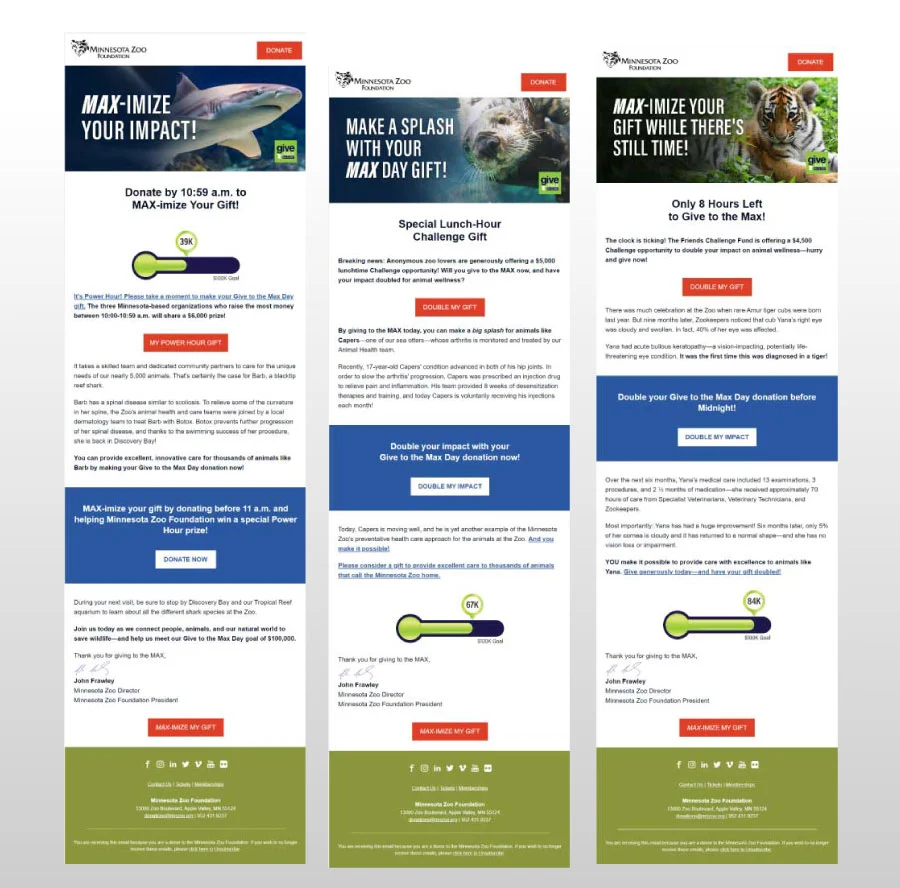
Direct Mail
Direct mail involves sending physical letters, postcards, and other materials to supporters’ homes. While you might assume this more old-school method isn’t effective, it can add a more personal touch and help you stand out in the crowded digital marketing space. Direct mail often appeals most to older generations who prefer physical correspondence, but younger generations also appreciate the tangible reminders of your work.
Direct mail can be more expensive than other channels due to printing and postage costs. Use these tips to maximize responses:
- Include your branding. Add your logo, brand colors, and fonts to each piece of mail you send. This way, recipients will immediately recognize that the message came from your organization.
- Leverage storytelling. Incorporate stories about your beneficiaries in your mail to evoke emotional responses. For example, a shelter might include before and after images of a litter of kittens it recently nursed back to health.
- Get creative. Push the boundaries with memorable designs. Add tactile, sensory, and interactive elements to the mail, such as glitter, foil, scents, textures, and pop-ups.
- Include a clear call to action. While you can’t add a clickable link to direct mail, you should still make donating easy. Add a scannable QR code or vanity/short URL that links directly to your donation page.
Example of This Communication Channel
Allegiance Group + Pursuant and the Georgia Mountain Food Bank (GMFB) collaborated to launch a campaign to distinguish its brand from its partner, the Atlanta Community Food Bank (ACFB), and enhance its marketing efforts. After launching a successful direct mail fundraising campaign for the food bank, GMFB saw a 61% increase in the number of gifts received and a 104% increase in the total amount given.
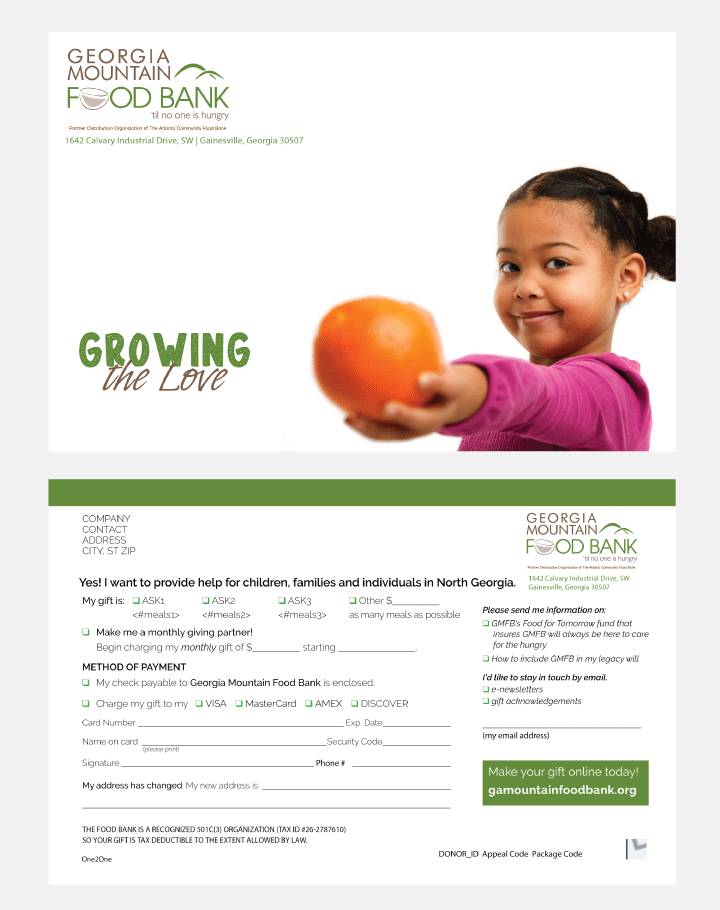
Website
Your website is the central information hub supporters turn to when they want to take action. Make it an easily navigable, comprehensive source of educational materials and ways to give back. Communicate your mission, the work you do on a regular basis, and your impact. Make sure to incorporate your brand visually and tonally to give supporters a consistent experience.
Implementing these tips can make your website more effective:
- Make navigating the site easy and intuitive. Ask yourself what members of your target audience are looking for from your site—are those pages easy to navigate to? Do pages load quickly? Is your website structured logically? Look at your website with fresh eyes to determine how to improve the user experience.
- Create engaging, valuable content. Don’t just copy peer organizations or create content for search engines. Instead, craft content that is relevant, interesting to your audience, and true to your mission and unique perspective.
- Drive traffic to your top pages. Identify the most popular content and the pages that drive impact for your nonprofit, like your donation page, and then feature them prominently and strategically. For example, the ASPCA includes a “Donate Now” button in its navigation menu, highlights the donation form on its homepage, and uses pop-ups to encourage users to donate.
Example of This Communication Channel
Rails to Trails Conservancy, a nonprofit advocating for community and environmental well-being, revamped its brand with the branding agency Outright. Our web design team translated the new brand to Rails to Trails’ website.
The team incorporated content highlighting the organization’s impact, funding information, and community stories on its top-performing pages. We also optimized site navigation for the audience’s specific needs. Following the site’s launch, the bounce rate dropped by nearly 9%.
Check out the new Rails to Trails site for yourself!

Call and Text
Similar to emails, both phone calls and text messages allow you to connect directly with supporters on their phones. Use this channel to share updates, make fundraising appeals, thank donors, and foster deeper relationships. This channel can also convey a sense of urgency and personalization that methods like email may lack. Additionally, donating via text is quick and convenient, breaking down paths of resistance that could prevent a supporter from donating.
To use this channel effectively, your nonprofit should:
- Be warm and personable. Especially for phone calls, strive to make the supporter feel like a valuable member of your nonprofit workforce. Greet them by name, ask them how they are doing, and show that you are eager to learn more about them and their connection to your cause.
- Explain your purpose. Because texts are a short-form medium, aim to convey the purpose of your campaign in just a sentence or two. Open with an attention-grabbing hook that makes curious supporters open the message. Then, seal the deal with a clear call to action (ideally linking to your donation page).
- Respect preferences and privacy. Not every supporter will want your organization to contact them this way, and that’s okay. Respect these boundaries by offering them an easy way to opt in or out of these communications at any time.
Example of This Communication Channel
Allegiance Group + Pursuant client Alabama Public Television (APT) launched an outbound text campaign to drive revenue for the organization. Our team worked to verify donor phone numbers to maximize reach and shared both stewardship messages and fundraising appeals. We segmented the supporters by sustained, active, and recently lapsed donors, sharing tailored messages with each group.
After the campaign, APT saw a 130% return on investment from these fundraising efforts.
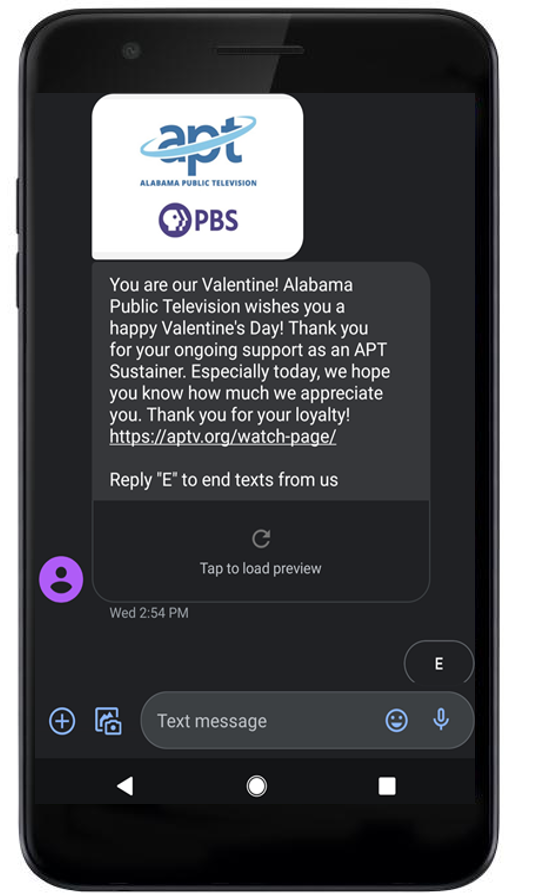
Social Media
Posting on platforms like Instagram, Facebook, TikTok, X (formerly Twitter), and even LinkedIn can humanize your nonprofit, show supporters the work you’re doing, and foster relationships through two-way communication. These platforms are excellent for telling your nonprofit’s story in a casual format and building an interconnected community around your cause.
As you post to these platforms, remember to:
- Embrace each platform’s quirks. People use different social media platforms for different reasons. For example, they might use TikTok to view funny skits and Facebook to keep up with family members and local events. Pinpoint your audience’s “why” for each platform and tailor your posts to that reason.
- Focus on the hook. Your social media posts only have seconds—or even fractions of a second—to grab users’ attention. Put your most engaging, sensational content at the beginning of the post, avoid large blocks of text, and lean heavily on visual media like images and video.
- Play along with the algorithms. Adapt to what’s currently trending to encourage social media algorithms to feature your posts prominently in users’ feeds. This may mean using hashtags, replicating a trend, or, on TikTok, using popular audios and video effects.
Example of This Communication Channel
The Truth Initiative is a tobacco-prevention campaign aimed at teens and managed by the organization truth. Allegiance Group + Pursuant and truth worked together to create a multi-step SMS, email, and social messaging campaign called “Not Happy or Healthy.” The campaign’s goal was to make young people aware of the issue of tobacco sales in Walgreens and gather signatures for a petition to ban these sales.
The social media aspect of the campaign leveraged the hashtag #NOTHAPPYORHEALTHY to build a social movement around the issue. It also included social media messages and graphics like the one below to inspire users to take action. The campaign secured over 5,300 signatures and engaged more than 67,000 young activists.
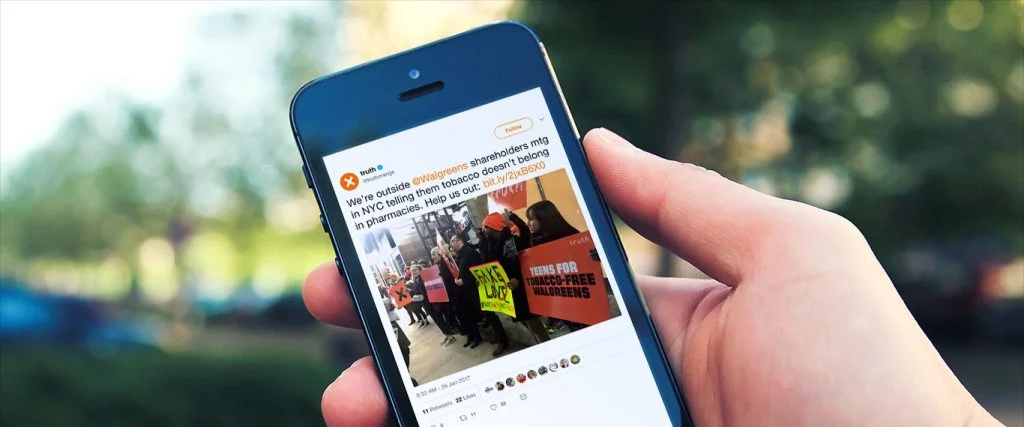
Paid Search
Search ads are sponsored search results that appear at the top of a search engine results page (SERP) for a designated keyword. For example, after searching for the term “fight childhood cancer,” an ad for the organization CURE Childhood Cancer appears as the first result.
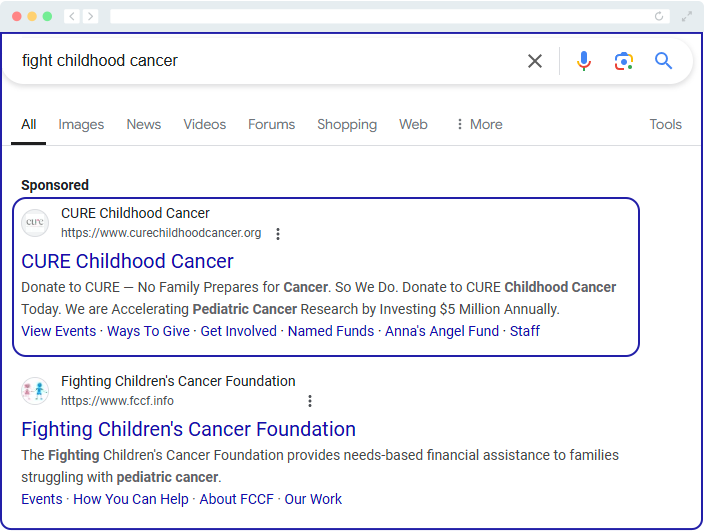
One drawback of these ads is that your organization must pay for them, and costs can vary based on many factors, like how competitive the keyword is, audience size, seasonality, etc. However, eligible nonprofits can receive the Google Ad Grant, a program that offers charitable organizations $10,000 in Google Ad credits per month. To get the most out of this program, consider working with an agency with experience running paid ad campaigns and maximizing the grant.
Drive more impact with search ads by:
- Carefully selecting keywords. Balance keyword quality, relevance to your cause, and competition. Opt for more specific, longtail keywords to hone in on your audience. For example, you might choose a keyword like “support children with leukemia” rather than just “childhood cancer.”
- Write compelling copy. Search ads usually include a headline and a description. Grab users’ attention and convey the purpose of your organization or campaign in the short headline. Then, add additional context and a brief call to action in the description.
- Optimize landing pages. Don’t stop at creative ad copy—ensure the positive user experience extends to the landing page, too. Check that the page loads quickly, is visually engaging, the page content aligns with the ad content, and clearly directs visitors to take action.
Example of This Communication Channel
Philabundance, a Philadelphia-based nonprofit focused on addressing food insecurity in the area, worked with our team to improve outreach efforts via paid search and social media advertising. The Allegiance Group + Pursuant team delivered a well-rounded marketing campaign focused on increasing the nonprofit’s visibility among current and prospective donors.
The results? Philabundance saw a 1,853% return on ad spend (ROAS) in paid search, a major win for the campaign.
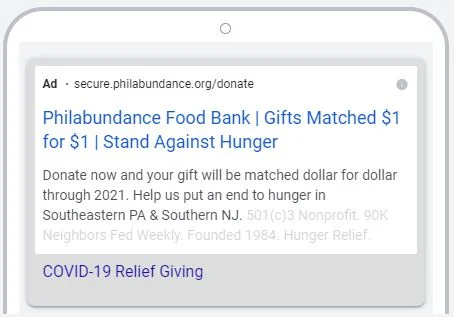
Wrapping Up
With the amount of competition in the digital marketing space, consistency is key. Launching targeted, high-quality campaigns that connect with donors across multiple channels will make your nonprofit stand out among all the advertising noise.
For expert advice, top-of-the-line creative input, and access to decades of experience in nonprofit marketing and fundraising, consider working with a professional nonprofit marketing agency. Our team of seasoned experts is ready to help you achieve your fundraising goals and engage donors through any communication channel. Contact us today!
To learn more about how to level up your fundraising efforts, browse some of our other top guides:
- 7 of the Most Effective Fundraising Tools You Need to Try. Your technology could make or break your fundraising campaigns. See all of the top tools we recommend here.
- How to Get Donations for Your Cause: 10 Best Practices. Need more effective fundraising appeals? Look no further than this comprehensive guide to securing more donations to fuel your work.
- Reach Full Funding Potential: 6 Donor Acquisition Strategies. Explore these donor acquisition strategies to expand your donor base with loyal, like-minded supporters.